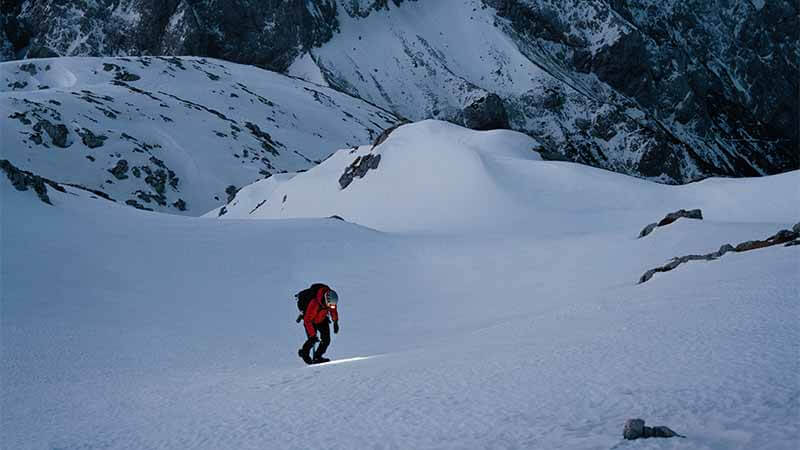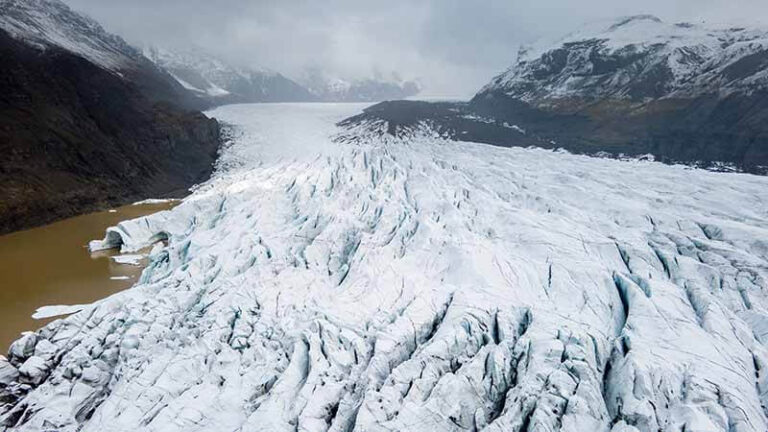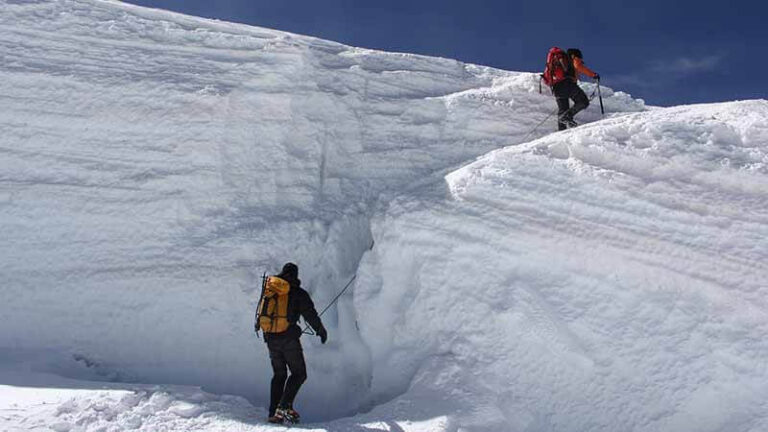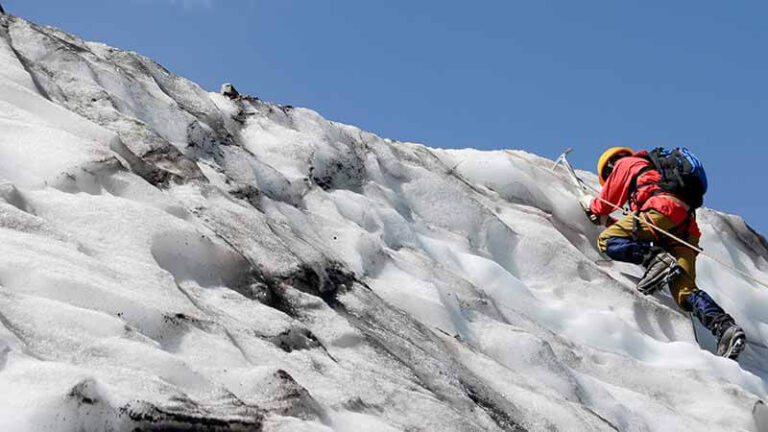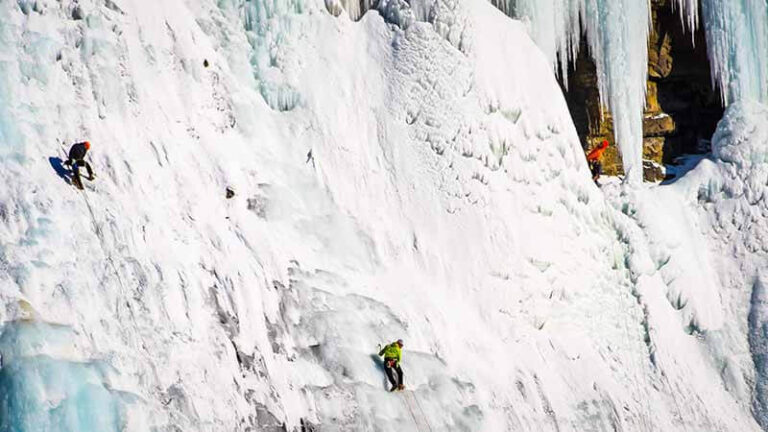Safety Tips for Using Ice Climbing Ascenders
Ice climbing ascenders are specialized pieces of equipment that play an important role in the difficult realm of ice climbing. Climbers use this equipment to help them ascend frozen waterfalls, glaciers, and other icy terrain.
Ascenders are primarily used to hold ropes, allowing climbers to easily ascend or descend. They are crucial tools for both rookie and veteran ice climbers, as they provide the mechanical advantage required to face tall and occasionally dangerous ice formations.
The primary purpose of ice climbing ascenders is to improve a climber’s safety, efficiency, and control while traversing slippery terrain. They accomplish this by requiring the climber to expend less physical effort when ascending, allowing energy to be saved for more demanding operations and lowering the chance of fatigue-related accidents.
Ascenders are available in a variety of forms and configurations, each tailored to certain climbing scenarios, making them valuable tools for ice climbers of all skill levels.
Importance of safety when using ascenders in ice climbing
Any outdoor adventure, including ice climbing, must prioritize safety. Because of the hard and harsh nature of ice terrain, safety becomes even more important while employing ice climbing ascenders.
Ascenders are safety equipment in and of themselves, but their effectiveness is greatly dependent on the climber’s knowledge, skills, and adherence to established safety measures.
The vertical and unpredictable nature of ice formations is one of the primary reasons why safety is of the utmost significance while utilizing ascenders in ice climbing.
Climbers are frequently hung on vertical ice walls, with only their equipment and expertise keeping them from falling. Ascenders provide a lifeline, but they must be utilized appropriately and securely anchored to function properly.
Aside from correct equipment use, ice climbers must be knowledgeable about different safety precautions, such as anchoring procedures, backup systems, and spotting frequent mistakes that can lead to accidents.
Weather conditions are also important in ice climbing safety because unexpected temperature changes can impair the ice’s stability. Climbers are at risk of mishaps without a basic awareness of safety procedures, which can vary from minor injuries to life-threatening scenarios.
Understanding Ice Climbing Ascenders
What are Ice Climbing Ascenders and How they are used?
Ice climbing ascenders are essential pieces of equipment that allow climbers to travel vertically on frozen surfaces such as icefalls, glaciers, and icy rock faces. They are crucial in the sport of ice climbing because they provide mechanical advantage and aid climbers in scaling ropes or fixed lines.
Ascenders operate on the principles of rope friction and leverage, allowing climbers to efficiently ascend the rope while minimizing physical exertion.
A climber uses an ice climbing ascender by attaching it to a rope or cord and then securing it to their harness. The ascender grabs the rope as the climber pushes upward on it, preventing it from falling back down.
This enables the climber to ascend by alternating between the ascender attached to the rope and their natural movement. Ice climbing ascenders are lightweight, small, and built for one-handed operation, making them perfect for usage in difficult ice climbing conditions.
Basic components and types of ascenders
Ice climbing ascenders are made up of numerous critical components that work together to ensure effective operation. Understanding these components is critical for climbers to select and use the proper ascender for their unique demands.
- Handle: The climber clutches the handle of the ascender to engage the device. Because ice climbing frequently includes extremely cold circumstances, it is typically ergonomic and intended for comfortable use with gloves.
- Cam: The cam is the main component that grips the rope. When strain is applied, the teeth or serrations bite into the rope, preventing it from slipping. The design and material quality of the cam is critical to its performance.
- Frame: The frame supports the ascender structurally and holds the cam and handle in position. It is typically built of lightweight but long-lasting materials such as aluminum or stainless steel.
- Attachment locations: Ascenders usually include many locations for attaching carabiners or other connectors. These attachment points are used to link the ascender to the rope and fasten it to the climber’s harness.
- Safety devices: Many ascenders have safety devices to avoid inadvertent rope disengagement. To release the cam’s grasp on the rope, these systems may incorporate a thumb catch or a lever that must be pressed.
Types of Ice Climbing Ascenders
- Handheld Ascenders: These are the most prevalent sort of ice climbing ascenders. They are designed to be held in the climber’s hand and are often used to attach to the harness with a locking carabiner. Handheld ascenders provide excellent control and precision while climbing.
- Chest Ascenders: Chest ascenders attach to the climber’s chest harness or rope access equipment. They are frequently used in tandem with portable ascenders to aid in the ascent of steep or near-vertical ice climbs.
- Foot Ascenders: Foot ascenders are specialized devices that attach to the climber’s footwear and aid in the use of leg power to ascend the rope. They are especially beneficial for assisting climbers on longer and more difficult ascents.
Safety Precautions Before You Begin
Ice climbing is a hard and potentially dangerous sport that necessitates extreme caution. Climbers must take various safety precautions before beginning on an ice climbing trip in order to reduce hazards and ensure a safe and fun experience.
Proper equipment selection and understanding of anchoring techniques are two essential factors of safety that are critical for a successful and secure ice climb.
Proper Equipment Selection
It is critical to select the best ice climbing ascenders for your individual route. Ascenders are available in a variety of forms and configurations, each tailored to certain climbing conditions and preferences.
The significance of correct equipment selection cannot be emphasized, as poor ascender choice can jeopardize both safety and performance.
First and foremost, climbers should think about the type of ice climbing they intend to do. A variety of ascenders are developed for different types of ice, such as waterfall ice, alpine ice, and mixed ice and rock routes.
Consider the diameter and condition of the ropes you’ll be utilizing, as well as the weather and terrain you’ll be traversing.
Climbers should also keep an eye on the quality and condition of their ascenders. Regular equipment maintenance and inspection are required to keep ascenders in top working order. This includes evaluating moving parts for smooth operation, checking for wear and tear, and verifying that safety devices are operational.
Anchoring Techniques
Proper anchoring procedures are critical for stability and safety when ice climbing. Anchors act as the foundation that holds climbers to the ice or rock face, keeping them from falling if they slip or otherwise fall. Understanding the significance of anchors and utilizing suitable tactics is critical for ice climbing success.
Ice screws, rock protection, and natural structures such as trees or ice bollards can all be used as anchors in ice climbing. The type of anchor chosen is determined by the specific climb and the available possibilities. Ice screws, for example, are frequently used to fix anchor points in frozen ice.
Anchoring correctly entails firmly placing anchors at appropriate spots along the climbing route. Climbers must ensure that the anchors are securely fastened and strong enough to withstand the forces generated during a fall or slip.
Furthermore, redundancy is essential in anchor systems, which means that climbers frequently utilize many anchors to give backup in the event that one fails.
To gain the necessary skills and judgment for safe ice climbing, it is critical to learn and practice anchoring procedures under the supervision of experienced climbers or instructors. Climbers should also be aware of the specific obstacles offered by changing ice conditions and adjust their anchoring tactics as needed.
Using Backup Systems
Ice climbing is an exhilarating but fundamentally dangerous sport, with climbers being exposed to harsh temperatures and difficult terrain. The deployment of backup devices is a crucial element of ice climbing safety.
These systems serve as a safety net, adding an extra layer of protection in the event that the major climbing systems fail. Backup systems can mean the difference between a safe descent and a potentially life-threatening situation in the unpredictable realm of ice climbing.
Introduction to Backup Systems
The installation of backup systems in ice climbing is necessary to underline their crucial significance in guaranteeing climber safety. Ice climbing frequently requires the use of ropes and mechanical devices such as ascenders, which are essential for both ascending and descending.
These major systems, however, can fail owing to a variety of circumstances, including equipment malfunction, environmental conditions, or human mistakes. Backup systems are designed to take over in the event of such failures, minimizing accidents and mitigating hazards.
Prusik Knots
Prusik knots are adaptable and extensively used ice climbing backup methods. These knots provide a method of friction hitching that allows climbers to efficiently ascend or descend ropes while also acting as a solid backup in the event that the primary system fails.
A prusik knot is made by looping a cable around the climbing rope and then passing it through itself several times. The prusik knot retains the rope and prevents it from sliding when strain is applied.
Prusik knots are used primarily for ascending a rope in ice climbing. Prusik knots can save a climber’s life if he or she needs to ascend a rope to reach a higher point or return to a safer location.
For increased security, climbers frequently attach prusik cables to their harnesses and utilize them in conjunction with a secondary carabiner. Prusik knots can also be used for self-rescue in the event of a fall, allowing climbers to re-establish their grip on the rope.
It is critical to emphasize the significance of prusik knots as a reliable backup mechanism. They provide climbers with a backup option in the event that their ascenders or other primary systems fail or become inoperable.
Prusik knot tying and use is an essential technique that all ice climbers should understand to improve their safety.
Tandem Rappelling
Tandem rappelling is another useful ice climbing method that improves safety during descents. Two climbers descend on a single rope, with one functioning as the rappeller and the other as a backup or brake person.
The brake person’s job is to manage the descent speed and to act as a backup if the rappeller finds difficulties or loses control.
Tandem rappelling is very effective when descending from difficult ice climbs with a significant risk of icefall. It adds another degree of protection by assuring that the rappeller is not completely responsible for their descent. In the event of a problem, the brake person can take control of the descent and avoid an accident.
A tandem rappel requires both climbers to be secured to the rope using appropriate rappel equipment and backup knots. The brake person often uses belay equipment like an ATC or a figure-eight, whereas the rappeller employs their preferred descending device.
During the descent, both climbers maintain regular contact and coordination, with the brake person ready to intercede if necessary.
Common Mistakes to Avoid
Ice climbing is a sport that requires accuracy, expertise, and a strong emphasis on safety. Unfortunately, even expert climbers can make errors that result in an accident. It is critical to be aware of frequent ice climbing mistakes and how to prevent them in order to have a safe and happy ice climbing experience.
Overconfidence
Overconfidence is one of the most dangerous aspects of ice climbing. Climbers who have had some success in the sport may get complacent, underestimating the difficulties of ice climbing. Climbers who are overconfident may take needless risks, violate safety regulations, or push themselves beyond their skill level.
Overconfidence can lead to mishaps in the following ways: • Attempting overly difficult routes without proper preparation.
- Ignoring safety checks or trusting that all equipment is in perfect working order.
- Ignoring warning indications of impending bad weather or avalanche danger.
Climbers must keep a humble mindset and constantly examine their skills and knowledge to avoid overconfidence. They must also be willing to turn back if the conditions become risky or if they face unanticipated difficulties.
Inadequate Training
Ice climbing requires extensive expertise. Climbers who attempt ice climbing without adequate knowledge and experience put themselves in grave danger. Inadequate training can lead to poor decision-making, incorrect technique, and a lack of emergency preparation.
It is impossible to stress the necessity of good training before attempting ice climbing. Climbers should seek out professional guides for instruction or take courses to learn key skills such as ice axe and crampon methods, anchor building, rope management, and crevasse rescue. They should also gain experience on easier routes before trying more difficult climbs.
Inadequate training can lead to accidents such as falls, equipment malfunctions, or becoming entangled in avalanches. Climbers must devote time and effort to learning the essential abilities and gaining expertise to reduce these risks.
Neglecting Weather Conditions
Weather conditions are critical in ice climbing safety. Climbers must be diligent in monitoring and responding to changing conditions because ice is extremely sensitive to temperature swings and weather patterns.
Temperature changes can affect the stability and strength of the ice, thus climbers must understand how weather affects ice quality. Warm temperatures can cause ice to melt and weaken, while cold temperatures can cause brittle, unstable ice.
Climbers should:
- Check weather forecasts before each climb and pay attention to temperature fluctuations to avoid weather-related mishaps.
- Carry suitable clothing and gear to be prepared for unforeseen weather changes.
- Develop the capacity to visually judge ice conditions and change their strategies accordingly.
- Avoid climbing on days that are warm or rapidly thawing, as ice conditions are likely to be poor.
Staying Informed and Practicing Safe Techniques
Ice climbing is a dynamic and difficult sport that requires climbers to constantly broaden their knowledge and enhance their skills in order to be safe and progress in their climbing abilities.
Climbers should develop an attitude of continual learning and regular practice to succeed in this tough environment.
Continuous Learning
Stay updated with the latest safety techniques
Ice climbing is a constantly evolving sport, with new equipment and safety techniques appearing on a regular basis. Climbers should make a concerted effort to stay current on these developments. This includes being current on gear developments, understanding the most recent safety measures, and being aware of previous accidents and lessons learned in the climbing community.
Resources for further education on ice climbing safety
Climbers can benefit from a wide range of educational tools like as books, online articles, films, and courses. Encourage climbers to seek out credible information sources and educational opportunities. Many climbing clubs and guiding services provide ice climbing safety and technique courses.
Join climbing organizations
Climbers who join a climbing group gain access to useful resources as well as a supportive network of experienced climbs. These groups frequently provide instructional events, workshops, and access to climbing mentors who may offer advice and share their knowledge.
Regular Practice
Value of regular practice and skill improvement
Ice climbing, like any other discipline, demands constant practice in order to retain and enhance skills. Climbers should make regular practice sessions a priority in order to strengthen their techniques and gain confidence. Practice sessions should cover a variety of abilities, such as ice axe and crampon methods, anchor building, and self-rescue.
How climbers can hone their ice climbing skills safely
Climbers should train in controlled situations before progressing to more difficult terrain. It is critical to begin with easier routes and progressively progress to harder climbs as skills and confidence grow. Climbing with experienced partners during practice sessions can provide significant information and safety.
Mental preparation
Mental preparation is an important part of daily practice that is frequently disregarded. Climbers should improve their mental toughness, stress management, and decision-making abilities. Climbers can improve the mental fortitude required for ice climbing by simulating difficult situations and practicing problem-solving.
Conclusion
One irrefutable truth remains in the exhilarating world of ice climbing, where the obstacles are as magnificent as the vistas: safety must always come first. As we continue this investigation of ice climbing ascender safety tips, it is critical to emphasize the unwavering necessity of prioritizing safety at all times.
Ice climbing is a sport that invites people to test their boundaries by ascending frozen cascades and conquering intimidating ice barriers. However, the nature of this quest necessitates environmental sensitivity and an uncompromising dedication to safety.
This article’s knowledge and ideas serve as guiding lights on your snowy adventure, illuminating the route to ethical and secure climbing methods.
The dangers of ice climbing are evident, from the unpredictable weather to the technical obstacles provided by frozen terrain. These hazards, however, can be avoided with the proper equipment, training, and mindset, and the benefits of the activity can be safely reaped.
Every climber must remember that safety is more than just a consideration; it is a solemn duty that supports every step and every ascent.
We enthusiastically encourage our readers to put their newfound information to use in their ice climbing expeditions. Equip yourself with the proper ascenders, grasp the skill of anchoring, and understand the importance of backup systems.
Avoid typical blunders, accept continual learning, and persistently practice your talents. This not only protects your health but also allows you to experience the actual spirit of ice climbing—a sport that combines thrill, precision, and a profound connection with nature.
So, as you set out on your next ice climbing adventure, keep safety in mind. Allow it to be the strong rope that holds you together, the dependable anchor that keeps you steady, and the guiding star that guides you securely back to firm ground.
Safety is your greatest ally in the world of ice climbing, where difficulties abound and adventure awaits. Prioritize it at all times, and may your ice climbing adventures be exciting, awe-inspiring, and, most importantly, safe.

